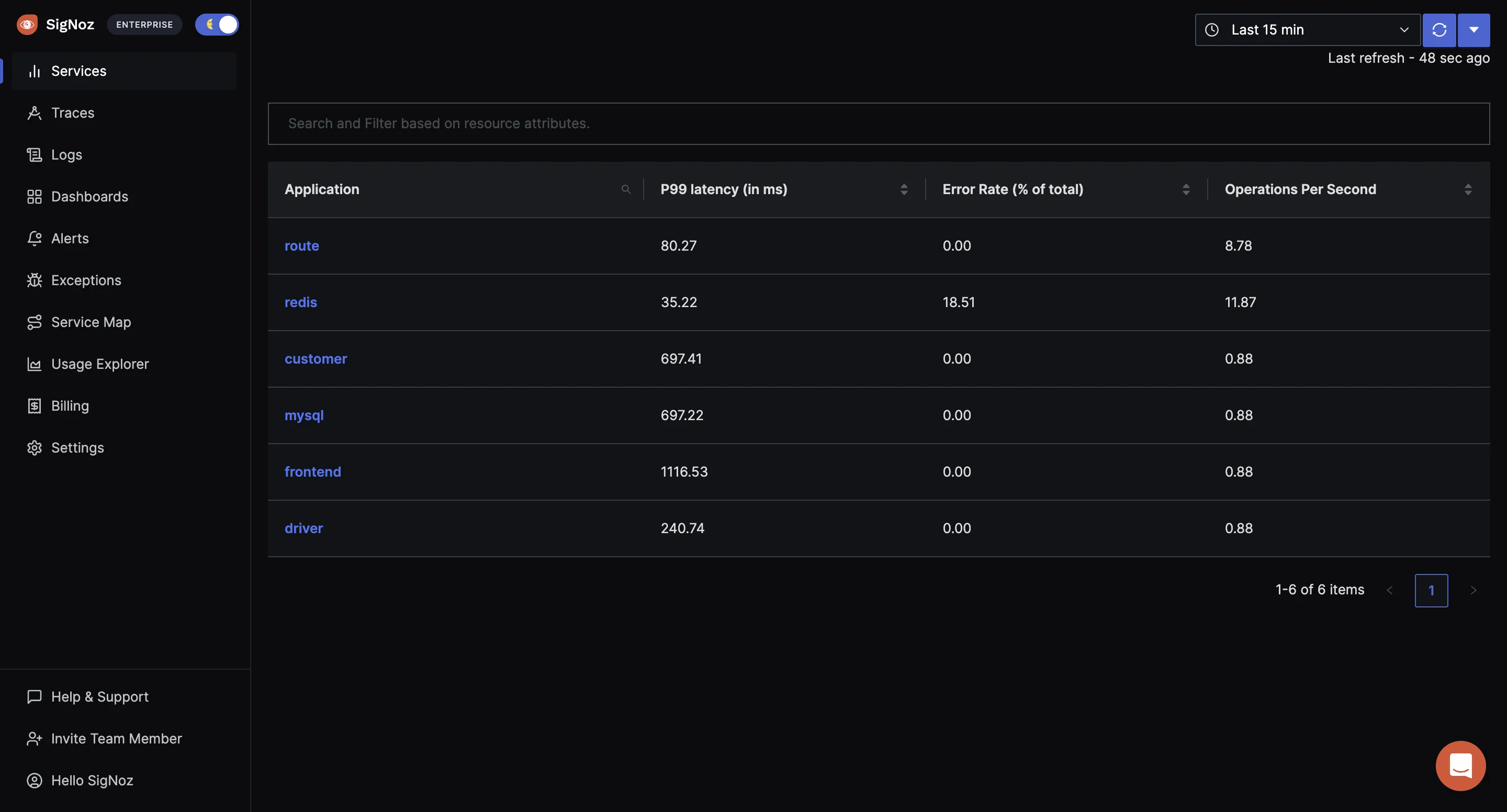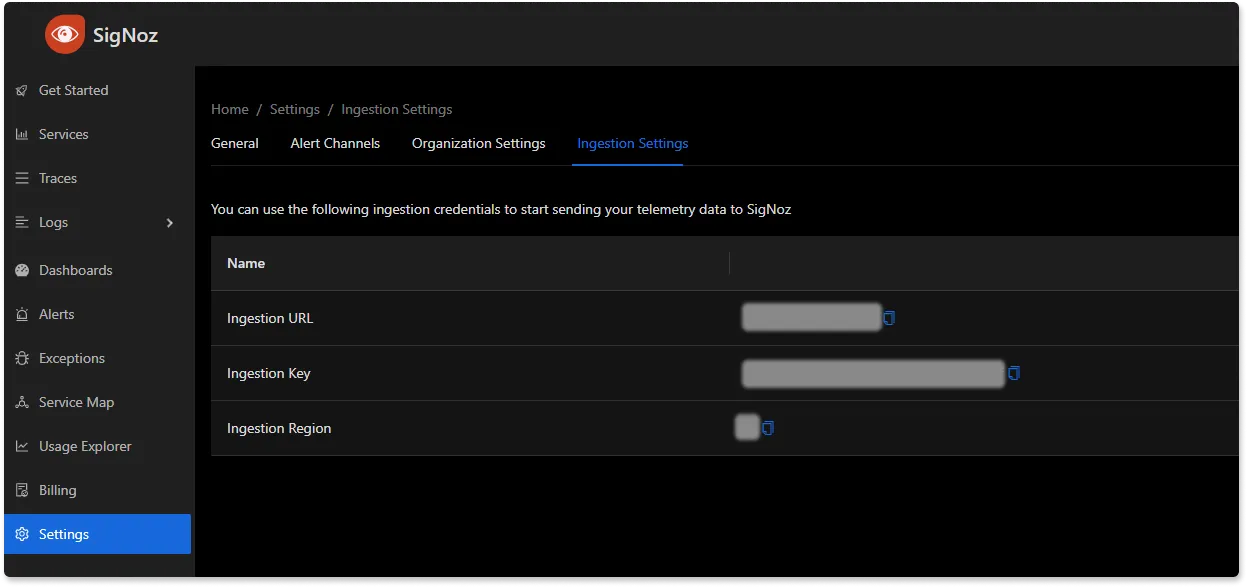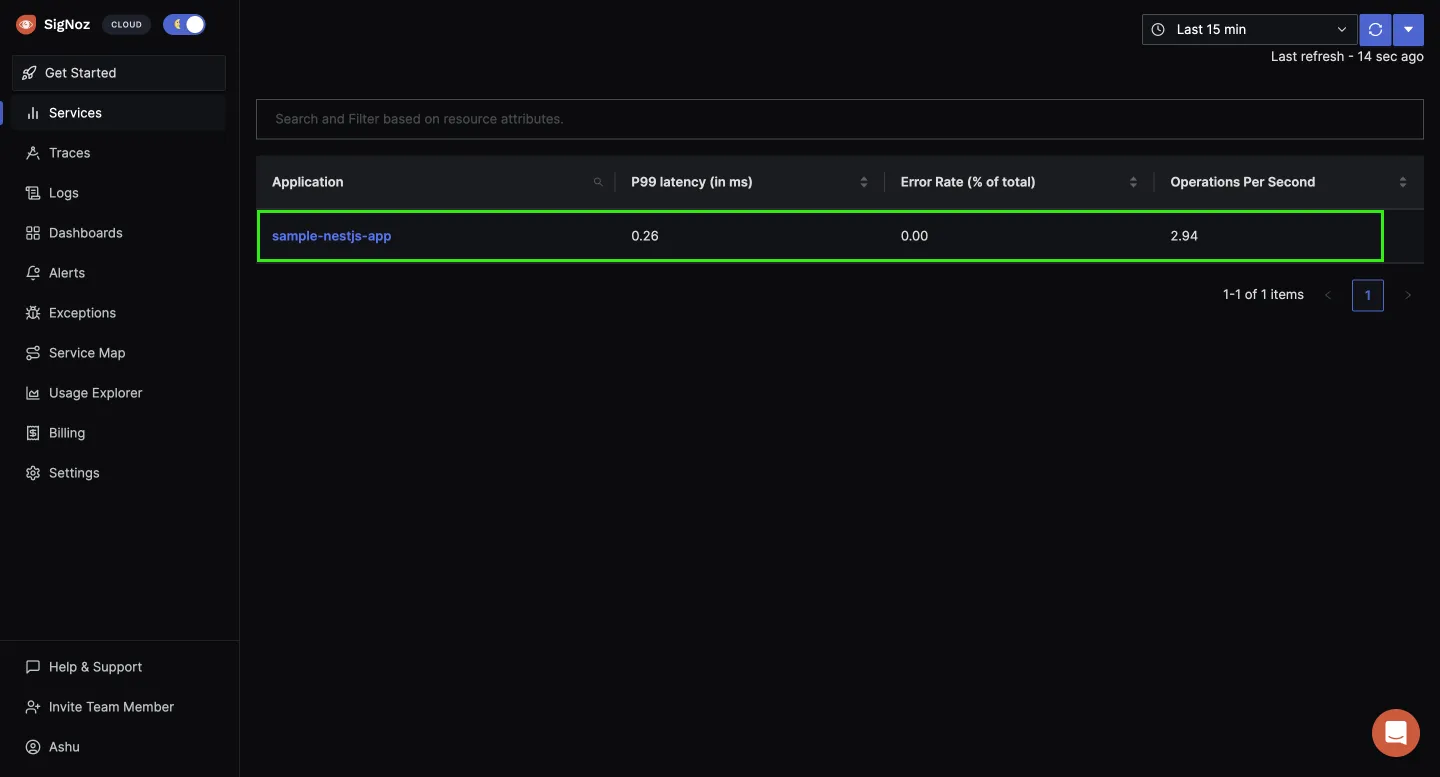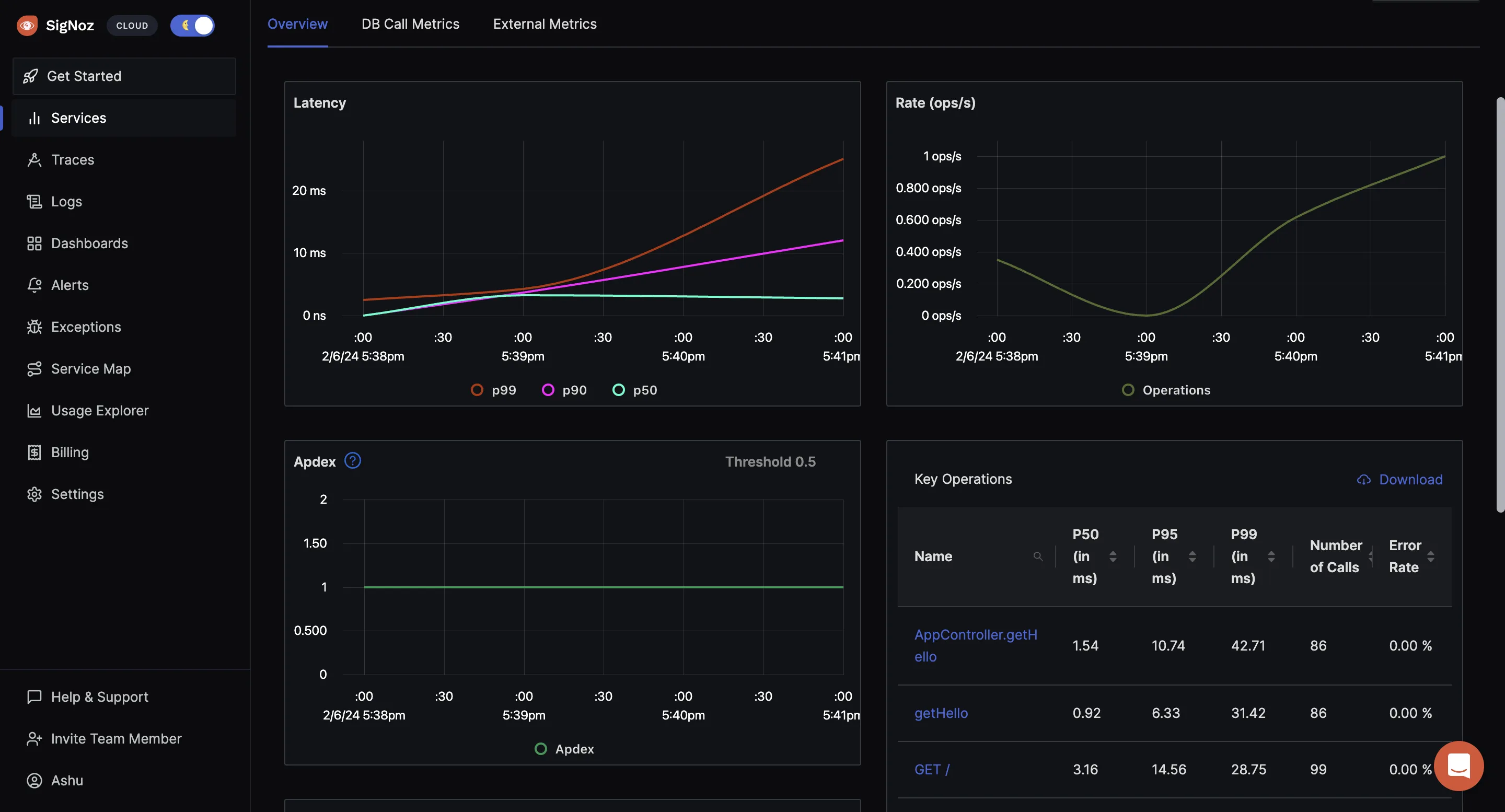Nestjs is a Nodejs framework for building scalable server-side applications with typescript. It makes use of frameworks like Express and Fastify to enable rapid development. It has gained wide popularity in recent times, and many applications are making use of the Nestjs framework. Using OpenTelemetry client libraries, you can monitor your Nestjs application.

Monitoring your Nestjs application is critical for performance management. But setting up monitoring for Nestjs applications can get cumbersome requiring multiple libraries and patterns. That's where Opentelemetry comes in.
OpenTelemetry is the leading open-source standard for instrumenting your code to generate telemetry data that can be a one-stop solution for monitoring Nestjs applications.
OpenTelemetry is a set of tools, APIs, and SDKs used to instrument applications to create and manage telemetry data(Logs, metrics, and traces). It aims to make telemetry data(logs, metrics, and traces) a built-in feature of cloud-native software applications.
One of the biggest advantages of using OpenTelemetry is that it is vendor-agnostic. It can export data in multiple formats, which you can send to a backend of your choice.
In this article, we will use SigNoz as a backend. SigNoz is an open-source APM tool that supports OpenTelemetry data natively.
Quick Start: OpenTelemetry in Nestjs
- Install packages:
npm install --save @opentelemetry/api @opentelemetry/sdk-node @opentelemetry/auto-instrumentations-node @opentelemetry/exporter-trace-otlp-http - Create
tracer.tsfile with OpenTelemetry SDK configuration - Import tracer in
main.ts:import tracer from "./tracer"; - Start tracer before bootstrapping:
await tracer.start(); - Run app:
OTEL_EXPORTER_OTLP_HEADERS="signoz-ingestion-key=<KEY>" nest start
Let's get started on the detailed guide and see how to use OpenTelemetry for a Nestjs application.
Running a Nestjs application with OpenTelemetry
First, you need to create a SigNoz account. Data collected by OpenTelemetry will be sent to SigNoz for storage and visualization.
Setting up SigNoz
You need a backend to which you can send the collected data for monitoring and visualization. SigNoz is an OpenTelemetry-native APM that is well-suited for visualizing OpenTelemetry data.
SigNoz cloud is the easiest way to run SigNoz. You can sign up here for a free account and get 30 days of unlimited access to all features.
You can also install and self-host SigNoz yourself. Check out the docs for installing self-host SigNoz.

Instrumenting a sample Nestjs application with OpenTelemetry
For instrumenting a Nestjs application with OpenTelemetry, you need to install the required OpenTelemetry packages first. Steps involved in instrumenting a Nestjs application with OpenTelemetry are as follows:
Step 1: Install OpenTelemetry packages
npm install --save @opentelemetry/api@^1.6.0
npm install --save @opentelemetry/sdk-node@^0.45.0
npm install --save @opentelemetry/auto-instrumentations-node@^0.39.4
npm install --save @opentelemetry/exporter-trace-otlp-http@^0.45.0
Step 2. Create a tracer.ts file
You need to configure the endpoint for SigNoz cloud in this file.
"use strict";
import { getNodeAutoInstrumentations } from "@opentelemetry/auto-instrumentations-node";
import { OTLPTraceExporter } from "@opentelemetry/exporter-trace-otlp-http";
import { Resource } from "@opentelemetry/resources";
import * as opentelemetry from "@opentelemetry/sdk-node";
import { SemanticResourceAttributes } from "@opentelemetry/semantic-conventions";
// Configure the SDK to export telemetry data to the console
// Enable all auto-instrumentations from the meta package
const exporterOptions = {
//highlight-start
url: 'https://ingest.{region}.signoz.cloud:443/v1/traces',
//highlight-end
};
const traceExporter = new OTLPTraceExporter(exporterOptions);
const sdk = new opentelemetry.NodeSDK({
traceExporter,
instrumentations: [getNodeAutoInstrumentations()],
resource: new Resource({
//highlight-start
[SemanticResourceAttributes.SERVICE_NAME]: "sample-nestjs-app",
//highlight-end
}),
});
// initialize the SDK and register with the OpenTelemetry API
// this enables the API to record telemetry
sdk.start();
// gracefully shut down the SDK on process exit
process.on("SIGTERM", () => {
sdk
.shutdown()
.then(() => console.log("Tracing terminated"))
.catch((error) => console.log("Error terminating tracing", error))
.finally(() => process.exit(0));
});
export default sdk;
OpenTelemetry Node SDK currently does not detect the OTEL_RESOURCE_ATTRIBUTES from .env files as of today. That’s why we need to include the variables in the tracing.js file itself.
About environment variables:
service_name: name of the service you want to monitor
https://ingest.{region}.signoz.cloud:443/v1/traces is the default url for sending your tracing data to SigNoz cloud. {region} will be your SigNoz data region. You can find these details in SigNoz dashboard under settings --> ingestion settings.
For creating the tracer.ts file for SigNoz self-host, refer to this doc.
Step 3: Import the tracer module where your app starts
On main.ts file or file where your app starts import tracer using below command.
The below import should be the first line in the main file of your application (Ex -> main.ts)
import tracer from "./tracer";
Here's a sample main application importing tracer.ts:
import tracer from "./tracer";
import { NestFactory } from "@nestjs/core";
import { AppModule } from "./app.module";
// All of your application code and any imports that should leverage
// OpenTelemetry automatic instrumentation must go here.
async function bootstrap() {
await tracer.start();
const app = await NestFactory.create(AppModule);
await app.listen(3001);
}
bootstrap();
Step 4: Start the tracer
await tracer.start();
Step 5. Run your application
You can run your application using the following command:
OTEL_EXPORTER_OTLP_HEADERS="signoz-ingestion-key=<SIGNOZ_INGESTION_KEY>" nest start
You can find your ingestion key in the SigNoz dashboard.

The data captured with OpenTelemetry from your application should start showing on the SigNoz dashboard. You need to generate some load in order to see data reported on SigNoz dashboard. Refresh your application for 10-20 times, and wait for 2-3 mins.
You can check out a sample Nestjs application already instrumented with OpenTelemetry here:
Sample Nestjs ApplicationIf you run this app, you can find a sample-nestjs-app in the list of applications monitored with SigNoz.

Monitor your Nestjs OpenTelemetry data in SigNoz
SigNoz makes it easy to visualize metrics and traces captured through OpenTelemetry instrumentation.
SigNoz comes with out of box RED metrics charts and visualization. RED metrics stands for:
- Rate of requests
- Error rate of requests
- Duration taken by requests

You can then choose a particular timestamp where latency is high to drill down to traces around that timestamp. You can use flamegraphs to exactly identify the issue causing the latency.

Conclusion
OpenTelemetry makes it very convenient to instrument your Nestjs application. You can then use an open-source APM tool like SigNoz to analyze the performance of your app. As SigNoz offers a full-stack observability tool, you don't have to use multiple tools for your monitoring needs.
SigNoz cloud is the easiest way to run SigNoz. Sign up for a free account and get 30 days of unlimited access to all features.
You can also install and self-host SigNoz yourself since it is open-source. With 20,000+ GitHub stars, open-source SigNoz is loved by developers. Find the instructions to self-host SigNoz.
FAQs
What is OpenTelemetry and why is it important for Nestjs applications?
OpenTelemetry is an open-source observability framework that provides a standardized way to instrument applications for generating telemetry data (logs, metrics, and traces). It's important for Nestjs applications because it simplifies the process of implementing monitoring and observability, allowing developers to gain insights into application performance and behavior without vendor lock-in.
How do I install OpenTelemetry for a Nestjs application?
To install OpenTelemetry for a Nestjs application, you need to install the following npm packages:
npm install --save @opentelemetry/api@^1.6.0
npm install --save @opentelemetry/sdk-node@^0.45.0
npm install --save @opentelemetry/auto-instrumentations-node@^0.39.4
npm install --save @opentelemetry/exporter-trace-otlp-http@^0.45.0
What are the key steps to implement OpenTelemetry tracing in a Nestjs application?
The key steps to implement OpenTelemetry tracing in a Nestjs application are:
- Install required OpenTelemetry packages
- Create a
tracer.tsfile to configure the OpenTelemetry SDK - Import the tracer module in your main application file
- Start the tracer before bootstrapping your Nestjs application
- Run your application with the appropriate environment variables
Can I use OpenTelemetry with any observability backend?
Yes, one of the main advantages of OpenTelemetry is its vendor-agnostic nature. You can export data in multiple formats and send it to various backends. The article mentions using SigNoz as a backend, but you can configure OpenTelemetry to work with other observability platforms as well.
What kind of data can I collect with OpenTelemetry in a Nestjs application?
With OpenTelemetry, you can collect various types of telemetry data from your Nestjs application, including:
- Traces: Detailed information about request flows and execution paths
- Metrics: Quantitative measurements of your application's performance
- Logs: Textual records of events occurring in your application
How does OpenTelemetry improve the monitoring of Nestjs applications?
OpenTelemetry improves the monitoring of Nestjs applications by:
- Providing standardized instrumentation across different services and libraries
- Offering automatic instrumentation for common frameworks and libraries
- Enabling the collection of detailed performance data without significant code changes
- Allowing for easy integration with various observability backends
- Supporting distributed tracing for microservices architectures
What are some best practices for using OpenTelemetry with Nestjs?
Some best practices for using OpenTelemetry with Nestjs include:
- Use automatic instrumentation where possible to reduce manual work
- Configure appropriate sampling rates to balance data collection and performance
- Use semantic conventions for naming spans and attributes
- Implement custom instrumentation for business-critical paths
- Regularly review and update your OpenTelemetry implementation as new versions are released
If you want to read more about SigNoz 👇
Golang Aplication Monitoring with OpenTelemetry and SigNoz
OpenTelemetry collector - complete guide

